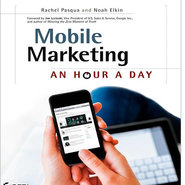By Rachel Pasqua and Noah Elkin
In the newly published book, Mobile Marketing: An Hour a Day, Rachel Pasqua, vice president of mobile at iCrossing, and Noah Elkin, principal analyst at eMarketer, provide marketers a guide for building a connected brand for audiences throughout the purchase journey through mobile marketing. The following excerpt is from the chapter discussing mobile Web sites, described in the book as the cornerstone of a successful mobile strategy.
Excerpt from Chapter 4 Week 3: Maximize Reach with Mobile Web sites
The importance of having a mobile website seems fairly obvious at first glance; your website is your brand’s calling card, and it should be findable, useful, usable, and engaging on any device a customer uses to access it. Yet, we still hear one question over and over: “Should I build a mobile site first or a mobile app?”
Mobile Web versus Mobile App
We’d like to answer this question by framing it in the context of the customer journey that we explored in Chapter 2, “Week 1: Develop Your Mobile Strategy.” When developing a mobile strategy for our clients, we always ask several key questions designed to help us understand the circumstances in which customers might find an app or a mobile site more desirable. For example, when talking to customers of the fictional Kiwi Market, we might ask the following:
• If you were looking for information on Kiwi Market on your mobile device, how would you start?
• Would you search the mobile web first and expect to find a mobile site?
• Would you look in an app store first, hoping to find a Kiwi Market mobile app?
• Would you download a Kiwi Market mobile app if they had one? If yes, how would you use it?
• Would you use it instead of the website? Would you use it differently?

Invariably, customers give us the same answers, whether they are shopping for groceries, a car, or a hotel room, or looking for any other type of information from a brand. In the early, getting-to-know-you stages of building awareness and consideration and even during a purchase, they prefer to use the mobile web. However, after they have converted and become a loyal customer, they often prefer an app if one is available.
When we ask them to explain these preferences, we hear:
“When I’m first looking for a product or service, I’m almost always using Google, Yahoo!, or Bing. Whether I use the site or app versions of these search engines, the results I get are website results—my mobile search habits lead me to a mobile web- site 99.9 percent of the time.”
“If I’m only going to connect with this brand a few times or if my interaction with it will be intermittent, say one to two times per month, I’ll probably stick with using the mobile site.”
“If my interaction is going to be more frequent, whether short- or long-term, I’d prefer an app if possible, but I’ll use the mobile site if there is no app.”
“I like apps better once I’ve become connected to a brand because the user experience is better. There’s less content I don’t want/need and it seems to be more tailored to my specific needs as an existing customer as opposed to the website, which tends to be more geared toward getting me to become a customer in the first place. Plus, the app often lets me save info and access it even when I don’t have a data connection.”
A mobile app does play an important role in the relationship between brand and consumer after that relationship has been established. As a rule, consumers see app usage as a sign of commitment, and they need to get to know you a little before they’re willing to download your app. That’s not to say apps never play a role in earlier stages of acquisition or awareness (in some cases, they clearly do), but it’s important to understand their position in the overall ecosystem in relationship to mobile websites.

The increasingly common accepted wisdom is that your .com site should be your first concern when getting started with mobile and should almost always come before developing an app. There are a few key reasons for this.
Reach - Technically, SMS reaches the most consumers overall; however, at a limit of 160 text-only characters, it’s not exactly an info-rich channel. Roughly 39 percent of the U.S. population (122 million people) use the mobile web regularly. Estimates suggest roughly the same number of people use apps; but remember, the app market is fragmented between multiple platforms. You’d need to develop applications for iOS and multiple versions of Android to even come close to reaching the same 122 million people you’d reach with a single mobile site.
Visibility - Google is the single most popular mobile search channel and the most popular mobile website in the United States. According to comScore, 97 percent of smart- phone users visited a Google site on their device in March 2012. Interestingly enough, the majority of these consumers used an app to access these Google sites. This supports our contention that, once users are deeply engaged with a brand, they tend to prefer an app. Bear in mind, however, that, Google Maps aside, the majority of the results these Google sites returned to consumers were websites. A mobile site that is well search- optimized will consistently reach the highest possible volume of mobile consumers.
Effort and Maintenance - While it takes a fair amount of planning and expense to design, develop, and maintain a mobile website, the effort of creating a mobile app is far greater. At present, you’d need to develop your app for iPhone with possible variations required for the iPod Touch and iPad as well as for multiple versions of Android. You may also have to consider BlackBerry and Windows Phone, depending on your audience’s technographics. Designing, developing, and maintaining for these multiple plat- forms as well as maintaining optimal visibility for your apps in the various app stores is a level of effort that eclipses development of a single, solid mobile website.
The bottom line is that it’s smart to make your mobile website your first priority. It enables you to best support the needs of as many new and current customers as possible, at a lower level of effort relative to apps. An added benefit of mobile websites is they will also be accessible to consumers who still own feature phones.
This excerpt is from the chapter discussing mobile Web sites, described in Mobile Marketing: An Hour a Day as the cornerstone of a successful mobile strategy. Reproduced with permission from Sybex. © 2012
Rachel Pasqua is vice president of mobile at iCrossing and Noah Elkin is principal analyst at eMarketer, both New York. Reach Ms. Pasqua at [email protected] and Mr. Elkin at [email protected].
{"ct":"c+bjWPI9YOijMmGLwVEaLB\/d0Cr3i+SAlE6skVNNim3MO3M15ra23bEEGBz7WZAtNW0TATHLOXfVaZcALTGBGQkqO3yg60SY4N0BhHRn\/S8LjqKcPCdo\/9I+nw2JWsVOyuc9MdytnvDWK6KQO7kzqEGejb7f6qzlxc41FY4wUF5VJ3Dslpz+fBjqOSfK77n\/V4RnvRUMKArSuLPjVbSINnsglz7wi5oJrQzp0Aue3EiWZGqdb\/oq6ce3yhjDV8elF3fikpaZCqXUDQphLFj9rKBBNwlidR55hOJMEhor14ZFCkorLtpGXR649Qf4dPsItvmLz02c\/OXvC+MzmTmuunc8rlDZiEJMY\/sON9GR+EDNF4Ok7Ik1LdbO2fASD3rQv5IhfvZJK7VkhCjFg0yNYYYxIsKD8dL4sBiBNBTr47q9dmCcI4qZPyBby37EhTQ8Q3EMhNW1\/FVWFS7IOvnCvaOQgcieLK5F9wxRDWjbdUgjXMfGsOnyMaR6dBJXL\/O9AgDUWAn7iAyE+pAYjmVzQR5OEQiyZclhunJlJ06lgAWoGb+UrxignMUq4dTfKH4UvYuCkyrseVEk7sPHArLtUBpVLuhoTWo8roGfscfSPRfCCa5qUxV6YG4lOQ+MW7dKFCOyogqaqyjYePQN9EDYG7myA07Eu8GLIsfQaXPuaV10DXSZaXFdCY5vTi2WX+U73fdPcEZKantbf6pg+2bTH2J0sAmF4Un3bCOT499rVgEvGmIhI8Geg5z+oBka3qvH1P53Oy4lY10MaIBeZZOPh4DACpmW7cGHdNX5YjrLzdaIpjttJjH6kyqFdf0Zl4wRdkIdjeTcKC9k7X8CkK7wM7I3DCG3a3vSKyZsdPKqMQ7YtlSSVQFWHQqTDYzvxwpKutJbarnsRDCTFyv5eSAjTImwBa1qtEJK+\/6qFXbcPr0OZ0dnhSb76q2+khywiC9ZZXFGz6wTjRRd2M56TMhUbjC42kgpEjkSEmqzL8i7JddVeP621Sjjwsi0Q1rELe+R19sTxNe\/zIVK8YU4nHDmcRZB\/VJy\/McNMvAupqRFLQTmTqrtrzLgBocksXRwbC9K5nkuakh78kf4g9UYrM6HCuwXAgdB5E9xczhE\/O6\/IOox8V3UZLoajWdLAlopGq7pUWI5uaf+Pin0Oy9KBtV1vQpsRP5tZyOMfRtXeKZPHEDwRk3VuYlL2+UAT30nRfaONyak7d75hD9pUnjlSCMy+u5\/zOkFaj6jtz641Z0c5Vsr50Z5ioZre6IbLvGiznehp\/7R9cuMobHNrxdAR2UC0J7U2Sm7r33i1Uhvd5Q06ozgsA5SmrfU0S\/CdRoN5LqyzcFbQTly7hrHKF3dQR7\/VQD1c0NusJP1zRCYqROuxanQmSHfCOuZgeo9np+Ni3YKbMx38W1DfDhSrEMAYkuSAb3E6E1JLtLk5N6LrPRKnymbsihFvOTkAxPw60Ex\/8dYKeJu1oOXSKD\/3JIwAmp4EI7QRWTQViHWiyRd8HkhoQp6xk6LudMtsTPPD5J7gdueI1QoHEDjYMPH2Vr3p0+z5Jnbmiygkv4yl\/Y3IyigvP+i4yLfgED9yFceynpMrCS3VZYHM76n\/p7sd7VQoe\/XwRAlha1gGuElgmH\/qoO4R0MK2vmulGvLwYdQx\/XlpsKqB6QRA6N6w0c+JDCbSGJ+81w\/5jbrD2LvSVrr3mUQfUiksi2RKUJsTyxZJcu4gqY+cm4qYxmt4HfAJkATYfFKZ1jvvGGAPG0dXHcx3v3Ysu7vd3EMM0NF0ivToq4xLPyKe7rrXHlov\/PFy8HPW5SRXl0etIBrQyKaAkru91epCr56rU0Igo4ygQkDRfOqqGcWRJ8unVV2jYAu7wpqXZLzzn5d2Whc7EjcmHr2yjH\/BV\/izgc9ZVAfdJJfAP1v9IgIX3M9PtR5Y5L1lUTN8Jc6POkoKDIAoIASzC2WADeyfe\/qm0av10QF4SFehGZd35aFeJ\/rTH7jJweKdoWcxW78JFfJ3b9ahijaBfAEU9dUw6Teo+SqFm4aVIS1A8W0lMGwj4MhHhAxwTtVIzvry+7iRF3BwkTpm4CkJld\/zCgnBeY\/GymhDl1uEDKEJHQ\/352tLfFYGDS\/pOtJr3t\/zzH9Na\/wlUpgRW\/Y0epFFVl7uMzBMrR6uw\/UNCA6noW\/HLRzJcMJUBCdDPfQMCawjyLqic4CBzqyWu5en0KNVjGdJfJ9RXXewMX\/d6SWmMhUbcrN43rX9efGV2d+PFVlghPtbFPMKoVBV3L3GdMH86eMAe9wC1ndYbNXgc9SU9mt\/HFvNnPUX0m6AT1\/6whbdOT32yd\/AEIy41Gjml+DlFJZSNxBRQeK7GAHs5dYZ+nszt1Pt3z3w7HYoHflV+F2WfsoHOx\/7IFJ\/7DM78X4cylBO07i7wIabgIS2HkDTo6Q4lpJPPTEWVOKkcGO6Dr+ann\/lKxk7qoz\/h\/P3dh3X9WF4rrQVLjNX\/6Pgsl4atSpYXWFcY8w\/w+2H8caZ9cWK7xvPRI4Ta7ob21QPovf3qIkR36vFpbN5d4gAwDS8GKgktnVxjl69qsKDe2wZWDyBQ7mypsFL1yeo7TLM4+pVZbJRqLPFrLCCDxQXRBiCFOLHEePSxnHwYL9ifxiltV3D\/vaX7lrQhRtiqSCu3mY00tSfe+eleu1Ql\/uVXjl5fbB\/fRPDoc\/FfNPTspE\/g+vF8pl0Of8EaZdRJL03qZdirxwdaqbTqwnm8VfxdVuhIup2O4BRWlGgMIGcNvfkQ0D0pvf6R6XEWS6H4wt8e0WSpvaP5gude955SmIzAKg9RpqkfIrK2L9oddlJuyaK9H8152zrqZEwwfRJhe6\/jRCVi\/6v6Lg\/8A1+gf+5Jl0GFgSwo84R+FFZfUGjcR2o1KOI7A0MSyM3bzGoC17Os8kj\/txK1uJYHNb4cc0nk7SGlhx0uQT4zFyVp6+oKKUNYHOhONK4neMf1YIxsd7qU2o42GyN+ChaIOYJb7N\/5hToIGjdosnt1tAAkrI0d5u0fMtQBdGBAeFyzMSce\/f2db4FMb\/FcplfNmZKdV0IFMSy1HyF\/WCoSDku\/ZluJtXwveRWwi0RASGLcAmXGkcXa3qemS4aB2Wt0XoTMU0FFqNspTEcXkjzNoq2sd8925ILe1+hA3a7pDD8I2Ocr3Zqe76j9e6bhuQmAn+5tIF7CbB7qDgzrMY5HItMlKr+S1QRLNzKEG9VMUF\/7Y5Cb5vQFhEdm\/6Yz5TswkmI9odrwwJeeETo73Ee9EkfaRaBJZtA60ohmS5e+P6qo\/3Cn+l1Tpqz1uQ06Ks37RPKQ93KOcHuMNsUMI0Ca2VczwCriCdJivrZIO0FYDcy7tP7zhlNqre9W0AOW28SznKax1URIbDvf0aRxxiMwzFZxr3OcewU\/K09UdGGKheXEK6sP\/CR\/bFzWVtIDnUUg5EcKVgC5eACkeRGZFBtUTPSXqbCAyWkCRumrz\/ou1hhegCNcyuxwFk4SIZRDCjMUY3FHpiRthuI\/K3cQq4ex94aAnTIns84g+pMQaeQVJGN8cKdRHG+f36xhRVEsyb2VdSK\/blySs3Y4HpmQnaxI\/MDwA9\/\/AKlRn95vhU1+WRqfVkq4iKNcC+be0jyXMZW1qB9IEAcfKfHGD3hx4PnwRRpz10nR7rZd1sIDrNHbNQ62X9+Q3Mjngwf4Qh9oPDxDRW9OSo1vdcftP8nGrmbAJ8BK\/ruRC7ip3uL3zwwomvJSfE\/zdkcMbFzAvtsYVnSmzxrUiwgouAVoNaOKsYQgB2fo09PbpC2Shrsun7L2ZyZSc++cKcDtU4kgrevdy\/Dv1kBfuUHZrhOLKW91LUeCQdC38SFzsVZ2J2+1O+8KWhNCN2p+bgIT3UFCpwm0NTCmj8JuS6MikXAgS2RpSJiQ2MrQTfItXbHmM\/O2jRO6MGyhG8JmVl6NhSLLm3ZJOcKZTY++uIMpsYJrEUpsk9GHUI6OA0DJ+IrBSl5B+pohDz9FibS69O1wpgCTLu0KluCKeq\/BpdJI0s1MvQShgqLBzzoutMofevH3r7DPUJnR2SQf2jh0V39fI89V8LqLHUrcO+UHaE7SQ0x0QrLr27UVOZFoCaJQ2jcaRCH0Jpwm2hjaW750BXirq3d+O2Qy+P5oR3WIFpF3WOqxSPH4zNcDnROSRWn+uhaPrvvfwTEPkRVgbKVQo4HFLyx6mlexnkygoRtuyATCQW3Af7b3CdbcJkmzJpXkR79nMJuksfvQywXZN2mNEQImQ\/PYyZdiRkfilPZj5eNRXzK\/+lKZShpEe57M1Ou\/NbrsNfUzSsF5j4SD65IyzkDuaOXeSftl\/uh1GFbbOf7YAtZS8CC5G6Qf13B6yuq+mIYL87XYordzJNybL4QGv8tAFEi2RvehOTfP0MhYJKieVHKnCDB3XW\/acCMS9XAFmp6U8Nl6k8z++TGXZhigOHb7t9KH6s2jZJPMEXEw9suzBa+hCQvGsDfd\/eK4umorhF2fbrvo0TP0Anp1TcplbyyLqDHSn98bQIxvXV6h\/F3Xp11zccBoeUAClscuBdmPYyJhnI0cEsRHdozig+x7OUKEDngSqVc3on8Qd7AHY4EAHR8OjVTnI8U9BfuRokNmNpv0JApU9zOtblEWlbRxpFiqpgLNpyYZBe5XmpDeplAWTdh99Nqq\/iRt5YmxwquhknJcHt\/bANa8HKqzlVqRyxHY1SHMjYa4L9Cx3M6Y2ke0x\/IwFMjmG9bBEW25rerlcA9m2yqYEoBoOPOCcwe3HBIj2GJVQmxyfmTY\/TEXJujnZm\/8E6sFrTED\/IYU7O06qe8nFtuwIqXBKK6MsYVvsdzZuoUQQCOeZNRRNke+way1T3ScrpqsbcnLVj9s+kN7dAELjAmSQl0U3cI7QjTjD4Cgt4+a404IEpQqU3udjvQs3EgQ5Dg\/HAhrbaaIcB28eoYcJUnZw68SsSK4+35mpj1MreBThXv\/oSYaNIfMX60qH69ctHOvAjcK9SWpuXkhOmKz2zSynFtbFeMvIuoqYYfDBy6wfox0gFaL9pOk1NLcPzSLXUwZq3hVaqISeFIG5vg2KQxmHr+3+cansKbnj30pI3\/RpeoRY29sd64J+z2MR4su3HkGcfSB0HZuInxiziWmzRpI2PFiU2CQkRePk1WYrJu0afRO3uRG8UApULk2m+7mHPNNtmIugHZ9nxvfuKf21H3g\/U1JNMp9gtcfmia4AGchwrTR8EM5MTWxynJ7LQYT6oeswWnXFpqwsKGLzM1t\/aty0ryMNZGeZc8prrng2n2W38t3zYez3Vw2Z1ID5fAsq77I7bhOKHJinRN2o2av15rKilqkgRaPSheTWkCsrUYXgV\/w\/Qwwr3HE+5Fle2SovqaedwtO2oZgGrf4AUYlovggIgtkilheuGOoutWy834qE522XdZy7V+ZLVO5tQi8Yr9UDxc89cmnzkTmr3oyDVAxEMQpnDrIx0T7eHz8ZFgEc41Ftup6b6iqUN2V5QsFZfX80Rt3Ih+xwXMB0E117LFnjzNvh58VpZRD6qLzqidLOTrDF+IVOCOgqZDaxOp8EB7rt0NiSBJRe8T0CYCDXX1mDabGY8X\/2f0Ht\/e2oLc7brsrksQZFw4vCZA+JEmVfzzf8U+aAgSWXEybQYdM4NjMY7u+dKoNyIyBPYATiCJQHsJWa7SUmznLhVQXuaBzs+wV\/BrtJ2g36IIVuq4FVAipksHmtuSWKTuCZHc4BKMYiJsKv+hMbs8j8HIDn\/Blesg4fm+DrDaFlq4\/YX6ykmE9JaAJfy2mZCtdrlLPxf3EDZ04TAeiREp1E1gJd\/xdaSRrn\/SVqFTahuJMwIELe5aNbUYhEXUoaGFhU5qdKILDtyQ5gMWSNQh2x4SjnM2EDBv22NOQVo901vv7S5JHKUNsWwQ7qlSLUi9ayqId4XPuUdmOqLkFx4VlMsJNUrLipKIoE5Jx9F5iHveJ8zE4v7nqdZvXrtxGWHN\/8AWsrpY5Lbz3s+OEXMn2DI30VmaRj1OCKFYFJwBQ6d2CjCQ\/ph2rlqxqrpfgd6ZC\/\/EfnmUPjvyRiUvtYLJjd5hJ5mv5l47hZgUwperKyO0b5knFqTNuojb\/O9LFgp1YL6g3alW4ugAwydH+wjFOZgH5roa+HrXaB07ByHuYKrr7obWt\/fX\/Kbrwy0iXLyAeugblIUy5\/bUqyYvCLldthVGvXDZ1Kqy3pf1JjqTMCjq5NX9xS9aSphNSKEpMjlRKoTGLP5Vx4DznQbG2AhJzO7oJoLODFHSV9KwoX3ZWjsS519bpbSCF4mQtiFy8MxUs5GFnUaF4+Z2fBQvLTkeFPHicG5v4wcJoVylens044LMXHSuvCKtLYjdIOG4TvR+BmHnPGNLiNmlVOHw6mnDr9+Grn2A7qNcyXBT0i879OVeW582kH0+wRRNpdXYe1pRRbzcXl5Cc2PR2DICMpn8+wP791Atc8ljY2P74uovVjliYnylGIE24mHX9FFS4mtQdmoMfLJ\/0AKAOdW6JwCd6rB2We4Pq1tHbdyOu99WvxNWk9hzauaKcXBQr5w6o+2x4kOYmupVGUSYOg6X5kxKGBd6VS1JunDu7nctVMSCQVZK6w55mZltrpHn9rAkAHJArg9mJNtypVJpVsllTHBPPUlgRL68tRYnqanriUz1QP\/LHsUdggnfHGHtHKQ9+vdg5TyqHY5Vk\/PLKmnknZHnL4\/JqBud7HUko7wwnDWnPkETyieMnVtdsf362xfpRkCXBc\/rDhLRRUolgFCpI9deTDcJCRovw+SfMS5q9h6B60VLoZbrSTDUEC4v7vhWa8VAIxPeP3\/Q5LqTyjYsEbsurU431Evo8nDIb9YniEPfRY8vnq0b7+NkN1TddVpvcB9iJQvOHiGcyZwkRD8dBSbt6vLf0sSJVcWQ58+F30pkVz7oR7cQ\/1PwUZm7gLaf75F5kXHXxkFPdFVYtqAGEQyRj8XrAP1ExuOt7LBnUAo8pxB4PFOt+cvzfZ5vn+F+FNsoFi9ogP2hfsP4FO0wQHg9\/9g2JNdF\/73\/LNHfgEDFHgctzRK9YpOBFjGkTJOfjh501yJ6miiADIiQQFupKEFxM7DqFojpvRBdk16FJjFaia2YSkJxfZTvwvd0aQYWazWqD+NAakY4Ht8gRqNK7qJhDovN8AOxKh+Uep38cxrw\/7H5t9g1VECRtYUzs66oamnbNW8nFCdFonII9uxXlj5hz1I\/noTdytlJOf8PsfP7O3zc4furcnxGfPtS06LucxMKHTKnKjSRDdsNviN8pP0FQH6Tl0Kd8u7L3cqBS3\/UbJGxDgV4UjhYS5Xo6tBsTC6p9AWaaj94s6uJ90MInQyYgBLApXauzOhGZZFJxs8pA0Mx2nfKOOG\/GUEMDPdak79AjVn8\/KkyFZDGFvKz6JYOFqFxwCgEmM0iQ8nKMJNxeM4ZXrAAZQoDugcUq8p6hFtFcFcBkb1aKVAtBYvGh1TYA10M7tOX\/bsa\/GYbtVbvda7RrcNbr8WJtq14yyyFkxcHSNM98nU1+ovl0aUq3nUaxeoTOUw4fL5d8z4JlAd\/6KljvuvCWTLtUWP2JIIxMOJMbqjY8nYqhcAp2EBhqJ3GyjyACrqTfklu4RJVqYhwtnz1mEFYSht5jpUUATArt7wolsZSWRCXkpkDylEx5um8iAVrlAFbwfwfxQCRRwB8HuC8nL\/Z+6r4Mk5rAxiG58fgelCFYZcb\/yw4wM+YAUr1F9kBcyIS6Q4MtpqhALHKc6NdP1hCmDBwiGpoZpE1bA0U6MBpM21b9O7PH5Qvuf9Sip47hgRgeVdj+sg2bbEzDrCrfVTVhlf9nSzMO8INA9irCivUn9IEgDK9rwQ1VkDIYufANtF2DvGYZ+mqbvmvwQVKY3JZvz2lsbOq1ebsmk2mHW0U+H4klBVvKwxmT3j3qGKNZsilkLxxybGdpDeUdyDuwKupcJ\/G1gLClm6GuBtbB9U2UnrwvVmi\/\/ezjkfHyTRIIoIK5Q02Knj\/a3wefz43k1aOUjmgHMOgx2Db\/yBdti9mOc3AVMRW7frWEG1TcRGgwiLhQE3cpM\/grDGyyXAGPoSG8qZzwPtA4WwGxl4ZyuEwYESR71Ch6BjzxFhsNculWzp0tsWreU5n0vPfwkLT3rJWTGsOH54C4ZBTQNtfWGTmZdLAI7McGemq3iZqSs1XqUNThDHspdsc3IQF2kEjXihT0bCQIWm0\/ylbtAb9754eJlwCI\/MnKsduIR9jVpeSqrHj5DcXvF8e4R2PpdAM42jOBemslfMS6ffjhXnZNfGIN18KH9n7gt0tu1ktJkraGAzH5rYI9bnFb3AtYSjd8FX\/TlaC1ycUOhUG0osJd9ZOF7gHSDbtxQ\/SaByD878+qgXHPBo0uqB9iHj1BLrvMl9bR+uODkdVxHbKPLQyVm3sto7ZeyHBLesETSpHTnmqwAzzWcRkfbconrBIWgB7QouO4yjg7gXZB7Ltypz+9UnQTzr13WfoYaJCeCa9t\/VaYKyv25dCnvTd+rWMoSDG86PUIM8DiDW\/4OYGQre7TEL5ekL3pfRtwhOXsk3dr6AaFgvBlkHRhRPuQbfSvB4PE6WmfmwlB3iHiQXOsQVgBnxilwlpUrIy0703Zf1kLxTRrEy7GAemDSV8lPXZWXoUPIrNOV+DR+eV9hO8hZnQY7QHlAQE3h+MgN\/6ySAPOd6IEaGgbPffTAdi8wudW71zmDeF0rp0PQtUKVhS9EObbzqOi91Od37xOxzSIKvYv+ovpPPJ+Winx8uVctSvq6MEEMo6Vve\/6Sj\/EIs8QMbGXeM9OFQ+FwHh9ZOKMsT+NwkC0EA1VCZyrvL1+CbyJQWbQJxTVJVDWZqB3eno0HsE64quDUUU2a54sY8DX9f63bcWUvbda+pSWPu1D9KPigA7XCTjkKgi0Khin3pzpPcxr9r0bYcncqGwKjqKjZmlAVLsmvyKUa3KMMeGseyCu+9xqMRk8uvuoKE\/9fMutJLNFwow+OgBdUnLP+suKu4JCwgl3g\/afW3IS15w5pbfibuGdVJLYVs93DyWXV5xSriyqCorfZ+EWir6hLNnS15rmp2KuSeU0DYqKMXyyQBAq04yxWH+DppisOZRENxtV6B0c26NjQqouz+jWiMYvfuleih3CasqcYxMF7V1usSc\/\/glvlOLitM9G96YdoexVGD26h94jl8yYD\/rJ6P9PoKMaSbt8cXZ9HYAbskVspPgJ+JIwycdCIKd76pq2820h0fDgVM6tOn7\/LD4+2KAhlPrQdH+UlWi8afWTCNBozGK7CCUHnlTjZTcOOwRSS6D2mtYjuausV0mcj+GhpGeo867CG0\/H1lKK5Kg4IY43mF4gmcFEEaErEVR4ptcfUcTe7AZn5n\/vsDrxU4JFvIWmY5ZS35olxVnWw8xusxNQ7jeymK1u0y1rn9TDBatp+\/P3rnTisfqRerVfE6bay16T4Ha6ULAXqp+Wf+U7M7iBquvBrqWlPvQ9Wqk8WI0\/SLhCuAae9mOdQw7VgGWzyyucuNGYbF26zKp0hUcQklrm35VHRMgtPKTaz\/5Qyc02BVfoKZwDNx7tEnoJwP0MiLG30WVAwSPwirShV1f\/rU62\/YgmvEUkJoUIG4eK6mTt3yccpU+2Vu6MZynllvYBymJuX7V1FndQdH0kfSd7T5LSNdFf6TmCef5CKjur9nslbQ\/GFItAg0g43KQSRwUmHOZdzSv1e92dfP6FbbpvF5Jat7Vyv9TuiP0nGUJtU\/WDPh6Vkr+wWigZ84EkzSCLuIgTmvrTVKHKOqTGHFgUh7RYuLCpGHYuNJoZk\/8pvPBbLGY02ZtCSqbGjplvR9sPuGz7EBf4hbY8+4Hk63Rv8JDm\/8L3mwY1UWBmDkNdq0gMNMpJSOP\/i4d+SOMHuM9zeTWqe0JKXYZ3WGMQSgff5Du79gLWN6HSb1lNezgyzW24ZHQW9f\/czMreQSjQ1nWA\/qPKIT9x4vad1ge4WuPtMGxly+muaYm3fOQjFpQjskkad7bbt5lr\/ziONlRGLK+Zc7VH3sG\/3wEREfGulJ3V5ICdvdzIrp\/EUnDA1b+foqhvpXsb2wYHMXqIu+tVLoLYhEabCwy\/kTVZxpvJBTByUxJKl1NDsWkgi53\/p4quMXIXCgRxUVH5vLaxkJ5JzTFDoKxW2B0KCon9PDEk2q5+zCf0aqT2GRlbNT2BDt1y9gs2Jsgz06OhhcbHHlkLIaYolPeTAjuPD8NyyLC7Hb2r6tPda0vqfz2mzfWzy330B7LALkYxsRE9bkZGrZ\/eKK+yp32rVTrrFiG\/CgvSmDiVgl7xDzx9paQCTrrlX67XfL94TzaGfljoORTm2\/LwA850v2E+241HMgxxrYC1DPD0a6Q0QReRKWr7\/N3dK4D\/M5w4ldRhgPZEXRY6h2CQS+T2slZiuZ\/MmRz+xw0t5Xtji5Cu4\/h9DB3wek59KcUIXzEGkmQKhmVp1J+1O1B5rFLbmrH\/CGxWN8\/aUX7Lzm6TUrut9oUgP93S2edUd+ZpMnjEvPR80YKilxxOidY4vwet59c8BQLe0NZfFIiSTe\/G5GplgPmfwx0h8WkKFRFZpzoShHGGWdawwfJBbBY1OocQM7xMR2GWJ1YpE4VGW+0z33YOPNojzVA1cUWz47HkcPXZGCTkYzs7cYgMOo4vrNkpp5oLPF8+dX3fcV3AS1Mnln2+hpE+UPAPhdxGWyaIIzw6WEceBtcOczxDEDWMTHGt4c1TWhkoxXdKXqGkcQwD2n13rdi6TlZDVYXdp0AUZ4t5OT095Pk7uvQcVa718kLsSqPJm478s5NU+QO1PJaY2BTMyMq4Ur6YMw+3dGpPaeUqK8hPBNPy6sNLodIVGjfLoEsuWYF61iGPBlkGJgZNuYvZf1ptRabQSKn2tRWECxlnX8ekcw\/v4hijp43ici0vD5GNsi+M4HgEIPCadBTWXipwg5JIQgBlDZNORXvWY7\/5kC\/5pvndi7LsE0WGNXqpfOw9jGX7MbiJJW+dt1Xm3UrTnjW6uUoRTS8DLLvqK8s7hi9DGZ4jjV24rXbwxAjh+x4\/2zQf4y34\/WViJ8rV6\/IvnhhFME8aLvFzVTFFsND3nRmxnX4tIvtwqi55gGtUgQKX69mmhpyzOL212GnA\/W+BS3ivZgqMzmzsUvRQ5Bna9l\/3mTRNmBvvs2KVcE3tGIeOuQLXZNJpBARNrsWudE9pj6lcqkmC5l8PypY\/K3LPxE\/LhB6EbHctz91GigjvLk1XFaWa7JK9SNo+9YlQKEubFs5sOR8AksuJ9xMVfWJ42tBqluN5xVyaKqtGNwnN6xkq9NOPb3NyfMeXYQf4qwjlMmbY0qgGB1VedufiIGtQ1yo5lQR5eDopEHfkH6iCEF+HIHJMW645k+WWr13NM6bwMRXeSVTpR+yYi9xJ\/TRVQWgPdEMHs5GEfIJVdOQZs6tJvK+ohXr4YIhWbNJQCcdGkpcoQU74P2Q+8fLehyZafBBw6VmePBSKPH2xPnLhOXPvlfoWnuYOfO2bJqrM2jBUMSGfwpu87Ml+iVS\/UEiYfrWCCpRLeAx6PYL3Zzvm5NWyqHGjkgNGLZjQWKe4EN5GsLYbaMHk2\/s0yDJY2veo7EeG00w4e9JWiLmH3OTIV3RR6DpeKGCuEtGB+i7DcAGBXkJKNUSnNRNYNviptudrxeIzBqs+bhqxJo\/1uQVhGmdbE4y1llqDjnsIR3ID6dolkj4Spoz3GUeWbhV\/K6qeaK32u19RZjV3\/j\/CY8JQDsBDgWJW28i1jOHLQD700A+yHNmcGwOdn32TBVvf\/MRYyOrhrCxLe4KpI4f+IwvwdhL509+RNx4dvCafds03GDy8Fg45HgVw1LEhqcIypQJrQNwLFEp\/e6Ke6oR4T177vctAFcwZ1wWNk6kat7bMtoNRCF7aYcNpaMGalbRtXIq5E1JjD3W2ecaHuA96Asw0ACWoOFykBcCSfBD7a7BfVeQHeTo+tV6eOxrrNr31H8YFsjRlxBrcxesWbqdG9rZ1c=","iv":"a85c16133c5b847bc543fa5d4e96acdf","s":"4efa37a1aecdaa8e"}
